Luc Van Lierde on lactate testing
Endurance Events and Lactate Testing
With Emphasis on the Triathlon
13 of 19
How to use lactate testing
to set and monitor training paces
An Important Use of Lactate Testing
Those who suggest that triathletes base their training on a lactate threshold heart rate or power measure are often providing inappropriate training advice
This section is on training intensity. Hundreds of books have been written on training and large sections of these books are about how hard and how long to train and when to use intervals versus continuous sets. We are certainly not experts on all types of training but we believe there are basic principles that will help you or your athletes to train better no matter the sport or the event. There are many excellent coaches out there with all kinds of training strategies, but there are some basics that should govern all training. Our point of view is based on the ideas of Jan Olbrecht. Jan has been the training adviser to several world-class triathletes, including Luc van Lierde, holder of the fastest time at Kona and the fastest Ironman time for 14 years. He has also advised dozens of other world-class athletes in swimming, rowing, running and motocross.
Four Essential Principles of Training
Here are four essentials principles that we believe should guide every endurance training program. They are:
- First - There are two energy systems, each extremely important. All training decisions must consider both. Every workout affects both aerobic and anaerobic systems. So a workout may train one system in the right direction but move the other in the wrong direction. So a lot of training is first taking two steps forward for one system and then because a different training type is necessary for the other system, there may be a step backward for the first. Training is a constant readjustment to reach a proper balance between the two systems. From Jan Olbrecht's "The Science of Winning:"
If you are not aware of our contention that the anaerobic system is an equal partner in the training process, you might want to re-read the triathlon home page again. We explain this in more detail on our four pages on the anaerobic energy system. Links are on the left hand side of the page.Designing a workout to induce just one specific biological adaptation is impossible. Most of the time there is a major effect (class effect) coupled with minor effects whether desired or not.
Recently one of our associates had an exchange on "Slowtwitch", a web site for triathletes about the nature of training. Someone had made a statement that they were not sure whether a certain type of training was beneficial or not and we replied with our understanding of training. Here is our reply:
Basically what we are saying is the aerobic and anaerobic capacity of the athlete determine how much aerobic energy gets delivered. An athlete has a specific aerobic capacity or VO2 max but not all of this is available for a race or training. What determines how much is available during a triathlon is related to the strength of the anaerobic capacity. A higher anaerobic capacity means less is available, a lower anaerobic capacity means more is available.There is a view on training that approaches the whole training idea differently. It is that the athlete has two energy systems (aerobic and anaerobic) that do two things. First they provide energy but second and equally important, they interact with each other to affect how much energy gets delivered.
So the objective for training is to train each of the two energy systems to an optimal level. Then the question is what type of workout best trains each system and each is as important as the other. The anaerobic system does not provide a whole lot of energy for the endurance athlete but it determines the level of the threshold and how much of VO2 max an endurance athlete can utilize during a race.
All physiological training affects each system. Very simply, you need to know what a specific workout does to each system. So every training pace or workout should be analyzed based on what it will do to each energy system. The following indicates that anaerobic capacity directly affects aerobic power, which is how much of one's aerobic capacity that can be used during a competitive event.
Any testing of an athlete, even a distance test, should try to assess the effect of the anaerobic system on the test results. This can be done by a direct attempt to measure anaerobic capacity. Lactate results after a short test to exhaustion are a good indication of anaerobic capacity. A lactate curve that is especially steep, in the first few stages, is also an indication of a strong anaerobic system compared to the aerobic system. A lactate curve that is flat in the first few stages and then rises suddenly almost straight up, is an indication of a strong aerobic system compared to the anaerobic system. A coach should train these athletes with these two types of curves very differently.
This focus on the anaerobic system is unusual in the training literature. Most treat the underlying condition that affects performance as sort of a black box. There are certainly references to VO2 max and the threshold but little is said about what causes either. or how a specific workout will produce the training effect desired.
- Second - The best way to train both systems is a combination of low-level workouts and very high intense training, though training at other intensities is sometimes useful.
Complicating the training problem is that there are elements of the aerobic capacity system that respond differently to various training approaches. There are three types of muscle fibers. Building aerobic capacity in one requires workouts that might not help the other fibers or even be detrimental. And before someone says that fast-twitch fibers don't produce aerobic energy, research has shown that even fast-twitch glycolytic fibers can develop a substantial mitochondrial content and thus produce significant aerobic energy.
Also what works for the anaerobic system may train one of the fiber types for aerobic capacity but break down the aerobic capacity in another fiber type. So there is no approach that will train all effectively. We have ran into a large number of people who believe that training near the threshold is the best training but we believe it is not the most effective way to train and can often be very negative.
• There is an online article in the journal Sportscience (13, 32-53, 2009) by Stephen Seiler and Espen Tønnessen, entitled " Intervals, Thresholds, and Long Slow Distance: the Role of Intensity and Duration in Endurance Training." This is an exhaustive review of the literature and discussions with high-level coaches that discusses what the very best athletes do to train. While there is no completely decisive conclusion, the overall conclusion is that the best training is mostly low-level workouts plus a much smaller percentage of high intensity training. Here is part of the abstract from this study:
Elite endurance athletes perform 80 % or more of their training at intensities clearly below their lactate threshold and use high-intensity training surprisingly sparingly. Studies involving intensification of training in already well-trained athletes have shown equivocal results at best. The available evidence suggests that combining large volumes of low-intensity training with careful use of high-intensity interval training throughout the annual training cycle is the best-practice model for development of endurance performance.
Jan Olbrecht has approached this problem a little differently. He looked at what the training literature said and reasoned to similar conclusions found in the Seiler and Tønnessen study about 20 years before their study was published. His work was able to pinpoint what led to the Seiler and Tønnessen conclusions by breaking apart all elements of the energy systems and what type of training affects each. Slow twitch fibers respond to slow training and high intensity training does not train them any better. But fast twitch fibers respond best to high intensity workouts. Olbrecht also found from personal experience that training that is too hard and/or too long will break down the body too much and will actually impede the process of super-compensation or increasing aerobic capacity. So because using too much high intensity training ends up breaking down too much and low intensity training builds mitochondrial content adequately, the low level training is preferred. The athlete must use high intensity training in small amounts to train the other fiber types and when necessary raise anaerobic capacity. He also emphasizes another very important function of low intensity training. It speeds up recovery or regeneration and he made this one of his most important principles in his book, The Science of Winning
When we suggest this approach to triathletes, they say that this is what everyone recommends. The differences between training strategies lie in what one thinks is low intensity. Some believe a threshold workout is low intensity. We believe this is an intense workout, much too intense for safety. What we mean by low intensity is between 55% and 70% of VO2 max with most of the training towards the lower end of this continuum. This is considerably below threshold.Rest or regeneration is the most essential part of training for inducing optimal biological adaptations.
There was a very long discussion of this topic recently on a triathlon website. They were discussing a video from a conference where Stephen Seiler explained this approach and provided some ratioale for it. Here is the link to the video
" MANAGING THE DISTRIBUTION OF TRAINING INTENSITY: THE POLARIZED MODEL."
There is another video from this conference that is a round table discussion about various topics. The following link takes you to this video. Then go to 23:30 into the video where Stephen Seiler and Steven Ingham discuss this training approach.
"ROUND TABLE - ISSURIN - SEILER - INGHAM - LE MEUR - HELLARD"
There is also an article to be published shortly that looks at the effectiveness of training intensity on Ironman performance. It indicates that lower intensity training works better.
"Training Intensity Distribution During an Ironman Season: Relationship With Competition Performance"
- Third - Each athlete is different and may not adapt the same way to similar training approaches. We may be violating the previous principle here but in reality are advocating that the coach be flexible with his or her athletes. If you start out following one method of
training, the athlete may not respond the same way as others will. We joke that we all have different DNA and that is why we are different but for training purposes it also explains why some adapt using certain workouts while others do not. Remember two athletes may have very different fiber types and these fiber
types respond differently to low and high level workouts.
Recent work in the microbiology of training has shown that certain types of workouts cause a chain of events at the cellular level that lead to specific improvements: more muscle mass, more mitochondria, more enzymes, etc. They also have found that not all individuals have the same genes and thus do not produce the same responses to the same workouts. This does not mean that this second athlete will not be a good athlete, only that different paths to improvement must be found. We once talked with a Belgian coach who said we do not have the number of athletes that a country like the United States has. We have to get the most out of each one, by finding out how each adapts. Only then can we hope to compete with the larger countries.
If you want to start a controversy in a training blog, suggest that training at the threshold is not good for the athlete because it stresses the body too much. You will get immediate stories of how hard they train and how much better they are because of it. It is like denying their essential identity to tell them not to train hard. Maybe some of these athletes are describing what works for them, and training at the threshold is good for some, particularly if they are not a high level athlete. However, we recommend that other approaches be tried over time, because there is evidence to back up their use. Maybe more intense workouts, alternating with recovery, should be tried if the athlete is not improving. If you are currently using intense workouts and are not improving, slow down most of your workouts but keep a small percentage of high intensity intervals.
- Fourth - the training must suit the event. The workouts for a 1500 m runner will be different from a 10 K runner or marathoner. As the time to complete an event increases, the types of workouts will change. A coach should not train an endurance athlete the same way a sprinter is trained. Trying to train athletes that will be competing at different distance in a similar fashion will not work.
Here is an anecdote from an Olympic training program. Two swimmers, friends, were selected to compete in the Olympics. One was a 1500 m swimmer and one was a 200 m butterfly swimmer. The conventional wisdom is that the 200 m butterfly swimmer is faster but you might guess that the 1500 m swimmer had a higher lactate threshold or MLSS (maximal lactate steady state) and you would be right. The coach preparing the swimmers for the Olympics put the two swimmers in the same lane and often gave them identical workouts in freestyle except for when the butterfly swimmer would be doing sets in the butterfly. After two weeks the butterfly swimmer started complaining that he didn't like the training, felt very tired after the workouts and was generally unpleasant. The coach told the swimmer to do the workouts or he would remove him from the team and he wouldn't go to the Olympics. Another coach, who personally knew the butterfly swimmer, intervened and asked if he could train him for rest of the time up to the Olympics. He slowed down the workouts for this swimmer since he knew from the lactate tests that he was swimming most of his workouts at or above threshold. The same workouts for the distance swimmer were well below his threshold. The new coach included 3-4 sets of 50 m butterfly each week above race pace for the 200 m butterfly swimmer along with the slower workouts. The results were that the butterfly swimmer won the gold medal at the Olympics and the other swimmer didn't medal. So the faster swimmer swam slower in most workouts but for high intensity swims he was obviously much faster.There are certainly many more things to consider than just these four principles when training. For example, all good training programs should be periodized and there should be weight training and workouts that emphasize technique. But these four principles are some basics to consider when choosing training paces for the athlete's workouts. We will now look at how to set training paces.
Typical approach to setting training paces
Let's look at a typical approach to training: identify the threshold and then adjust training paces off of this threshold. We will then compare it to other ways of setting training paces.
Heart rates, power levels, running, cycling and swimming speeds at an estimated threshold are frequently used to set training paces. The question is what formula to use. Few then question if the formula once chosen makes any sense. Our experience is that athletes want to be told what to do and few question algorithms that set various zones for training. One rather unsophisticated way that is very common is to do a distance test in each of the three sports. Here is an example.
Run for 30 minutes at your max rate and for the last 20 minutes take your average heart rate. The speed for this 30 minute run will be your lactate threshold speed and the average heart rate for the last 20 minutes will be your LT heart rate. Training is based on this heart rate. Some percentage such as 75% - 85% is set as one's aerobic zone and then an anaerobic zone may be set at some other percentage such as 95% - 105%. All who do the test are treated the same. This is a very simple approach; other coaches will set much more elaborate zones based on various percentages without questioning whether a zone actually has the desired effect one wants or any evidence that it does produce the specific effect. More often than not no specific effect is delineated other than to spend some amount of time in a specific zone. Later this test will be repeated and new zones set up, based on the new threshold.
This may be appropriate for a recreational triathlete but is definitely not for a serious athlete. At best this test is an estimate of the threshold. It requires that the athlete perform a max effort; there is no way an athlete can know if he/she could have gone a little faster. It also fails to recognize that athletes are different in other ways besides their threshold times. There are other issues: a specific zone may actually be counter-productive for the athlete. The “aerobic zone” may be too stressful for an athlete with a low anaerobic capacity.
If you are a triathlete or coach triathletes, then you know there are multiple formulas out there. We have not seen any firm basis in science that a specific zone produces a specific physical response in the athlete other than it seems to work for some. Certainly some training is better than no training.
The value of lactate testing - So can lactate testing do any better? After all, it is just another physiological marker like heart rates. A test gives the V4 for each discipline and a very good estimate of the threshold. The V4 is easy to calculate and a reliable measure. What the coach or athlete then does with these pieces of information is the real key to success. If they use a fixed formula based on lactate testing, they will fall prey to the same problems as those using heart rate zones. That is, unless they adjust the training zones based on an anaerobic capacity test, an estimate of VO2 max and feedback from the athlete, and are willing to adjust training approaches based on the athlete’s response, they will not find the best training practices. The feedback we refer to is the next lactate test, either a control test or another standardized test protocol.
Before we go on it is worthwhile to talk about the ease of this test. Yes, you do have to take a few lactate readings and some will find that intimidating. But compare this to the effort to do the 30-minute test correctly. Some believe it takes a 60-minute test to get the true threshold. We have talked to several people who have done the FTP distance test who find it a real chore. It also requires strong motivation to do the test correctly. A lactate test only requires that the athlete spend about 5-6 minutes at threshold or slightly above it plus a couple more stages at sub-threshold intensities. No motivation is necessary because the stages are easy and as someone once told us, "the blood never lies." If you follow our protocol then the athlete will also do an all-out effort about a minute in length and for this, motivation is required.
Percentage Calculations - There is nothing wrong with making a percentage calculation if it is used just for a start to a long-term training program or if the coach has experience with specific training paces. We have worked with Jan Olbrecht over the years and he has very sophisticated programs for evaluating every training pace based on the athlete's aerobic and anaerobic capacity, body type, past training history. But even Jan will adjust as he learns if an athlete is not responding as expected. Wherever one starts, the end point is to find the best training practices for that particular athlete and they could be very different from another athlete that had similar initial testing results. The lactate results steer the coach or athlete to the best training practices.
When dealing with recreational athletes there are easy ways to calculate regeneration and extensive or what are called aerobic training levels for swim, bike and run, and what some intensive or more anaerobic effort levels are. Any training program can make use of these levels or establish other levels in order to plan training.
For example, here is a simple way to estimate regenerative or extensive paces from a V4 pace. For a recreational triathlete, estimate regenerative or extensive paces at about 85%-90% of the V4 pace. For example, if the V4 is 3.30 m/s or about 5:03 per 1000 m then the regenerative paces would be about 3.0 m/s or about 90% of the V4 pace.
For an elite triathlete whose V4 pace was 5.49 m/s, the regenerative pace would be about 3.9 m/s or 70% of the V4 pace. To the normal observer, this sounds odd. The low-level triathlete can do most of his volume at 90% of the V4 pace, while the elite triathlete who competes with the world's best must do his regenerative workouts at 70%-72% of his V4. But if one realizes that the V4 of the elite triathlete is probably about 92% of VO2 max while the V4 of the recreational triathlete is only about 75% of VO2 max then the recommendations make sense. Both athletes would do regenerative workouts at about 68-70% of VO2 max.

Notice that the regenerative pace of the elite triathlete is about 20% faster than the V4 pace of the recreational triathlete. In other words if the recreational triathlete ran as fast as possible, he would not be able to keep up with the elite triathlete doing an easy run. Most triathletes are between these two examples and as serious triathletes get closer and closer to the elite status, they have to worry a lot more about how fast their paces are during training.
Before we discuss what to do with an athlete that is between the recreational triathlete above and a potential top 10 finisher at Kona, let's discuss what each athlete represents. One is a relative novice while the other is one of the best in the world. The elite triathlete has a long history of successful training seasons and knows what works and does not work for him. The recreational triathlete is entering a new world and should be cautious as he learns what best for him. As this athlete trains and tests over the next two years his conditioning should improve and his focus should be on increasing aerobic capacity. He will not pay as much attention to anaerobic capacity. His coach should gradually lower the percentage of his V4 to calculate his regenerative runs. It started out at 90% for regenerative runs but as the V4 moves to the right, the percentage should drop to 85% or even less.
Comparing Athletes
The following chart quickly indicates where a particular runner would be compared to other runners of different abilities. Our elite triathlete, one expected to do well at Kona Ironman World Championship, would be on the far right of the chart. The running ability of an elite Ironman triathlete is similar to that of a 2:20 marathoner. No Ironman competitor has ever ran such a fast pace in an Ironman race, but if the only race of the day was a marathon, then we would expect the top Ironmen to finish around 2:20. The fastest marathon ever run in an Ironman race was about 2:36.
So when looking at the V4 of a running test, one would look at whether one is closer to the elite triathlete or the recreational triathlete and set regenerative and aerobic paces accordingly. They will be somewhere between 3.0 m/s and 3.9 m/s. If the athlete knows his VO2 max then he can set the paces at 70% or a little lower.

If the athlete is anywhere near world class, then his or her V4 is very near VO2 max and regenerative paces will be much lower as a percentage of the V4 than a lesser athlete will do. So it is not correct to use the same percentage for each athlete. The more successful the athlete, the more careful the coach has to be with the overall intensity of the training volume.
An interesting example - What do you do about the following? The chart below is a cycling lactate test for a serious male triathlete and it is determined that his threshold is 225 watts which is also his V4. That is not unusual as thresholds for cycling take place at higher lactate values than they do for most endurance runners (running thresholds tend to be between 2-3 mmol/l). He also had a VO2 max test and it was determined that his aerobic capacity was very strong - almost 70 ml/kg/min. His threshold VO2 was between 65% and 70% of his VO2 max. If you took 75% of this threshold power then it would be about 50% of VO2 max and hardly training his aerobic system at all. This illustrates one of the problems with using one formula for all. The high lactate value at exhaustion during the lactate test, the shape of the curve with no real baseline point to a high anaerobic capacity. This athlete should do an all-out test to confirm the high anaerobic capacity and then set training objectives to bring it down while continue to raise his aerobic capacity. As he continues to train, he should test and see how the lactate responds and whether his training is helping him reach his objectives.
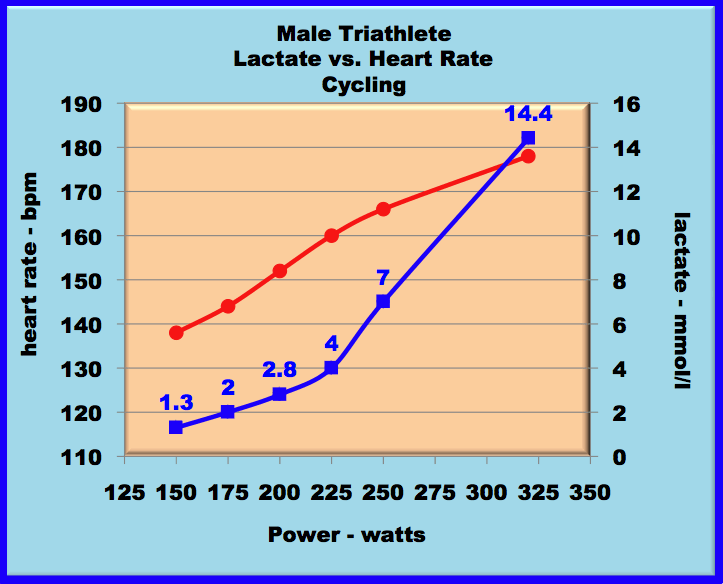
Here is an example at the other end of the spectrum which is also common with endurance athletes in general. This involves a female triathlete with a very low anaerobic capacity. One of the main reasons why someone becomes an endurance athlete is that they have a low anaerobic capacity and can run, bike or swim long distances with out much trouble.
This athlete completed three 2000 m runs on a track at roughly 15 seconds faster for each 2000 m. Based on the lactate results of this test (V4= 4.7 m/s), this athlete should be an elite female triathlete as least in running. But she was not based on her competitive experience. She then completed an anaerobic test, a 600 m all out run and only generated 3.9 mmol/l of lactate. This is extremely low and it means that her V4 was highly influenced by this low anaerobic capacity and over estimated what she was capable of doing aerobically. In other words at each speed she was using a much higher percentage of her aerobic capacity then the the V4 indicated. She had to slow down her training. If she had completed a standard distance test, running all out for 30 minutes, the result would have distorted her threshold substantially and her aerobic abilities.
Her training would now include one anaerobic capacity training set each week and her aerobic and regenerative runs would be slower than normal for an athlete with this V4 (regenerative and aerobic sets would be between 65% and 75% of her V4 with more towards the lower range.)
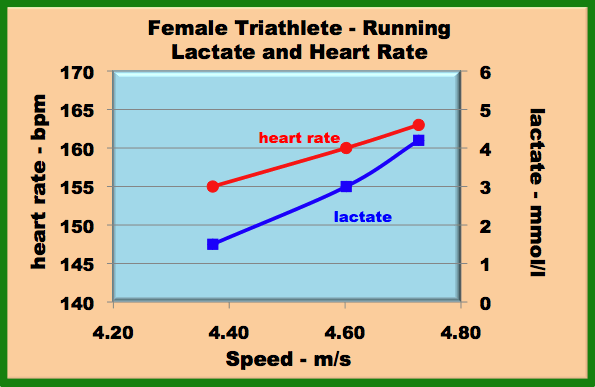
MLSS
If a coach feels it necessary to calculate a MLSS or lactate threshold, then the Secrets of Lactate CD has several testing protocols which allow him or her to use a lactate analyzer to do this.
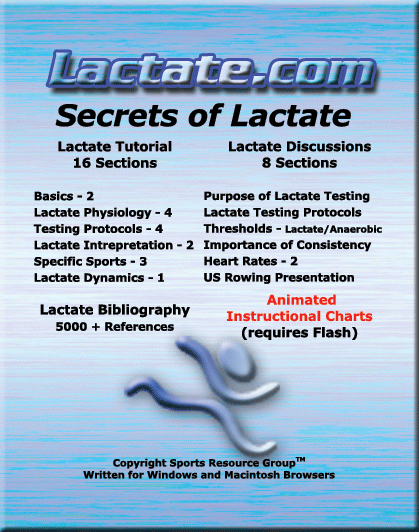
In the near future, there will be a thorough discussion of thresholds by Sports Resource Group. Two recent articles have discussed this in detail.
Faude, O., W. Kindermann, et al. (2009). "Lactate threshold concepts: how valid are they?" Sports Medicine 39(6): 469-90.
Binder, R. K., M. Wonisch, et al. (2008). "Methodological approach to the first and second lactate threshold in incremental cardiopulmonary exercise testing." European Journal of Cardiovascular Prevention & Rehabilitation 15(6): 726-34.
Perceived exertion - Perceived exertion or the subjective reaction of the athlete to a set or workout can be very misleading. Two different athletes may have very different reactions to training sets at various percentages of VO2 max. Here is a chart of swimmers with similar perceived exertions (RPE) but very different lactates. So one swimmer telling the coach how a set felt is reporting an entirely different metabolic experience than another swimmer with a similar description. One may be generating almost no lactate while another may be generating quite a bit. So one is engaging the anaerobic system at a much higher level than the other.
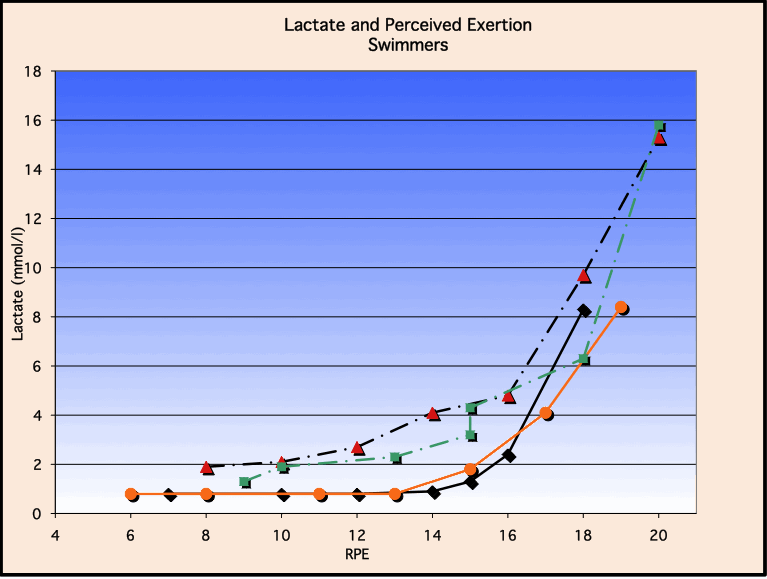
Below are these same swimmers plotted differently. The X axis is speed and it easy to see that their V4s are quite different. The training paces for each will be different and not necessarily proportional to their V4. Swimmer D's V4 is 8% greater than Swimmer C's V4 but he may only train at 4-5% faster swimming paces than Swimmer A. The reason is that Swimmer C produces a lot of lactate and the V4 underestimates his aerobic capacity.
Swimmer D was one of the best swimmers in the world and his V4 represents the upper end of what one can expect to see with any swimmer. Also these tests were based on a 7 x 200 m protocol commonly used in analyzing swimmers. A test using 400 m swims would cause the V4 to drop off about 2%, but it would be difficult to require 7 stages of 400 m. Swimmer B was also one of the better female swimmers in the world and can be used as a benchmark to judge other swimmers.
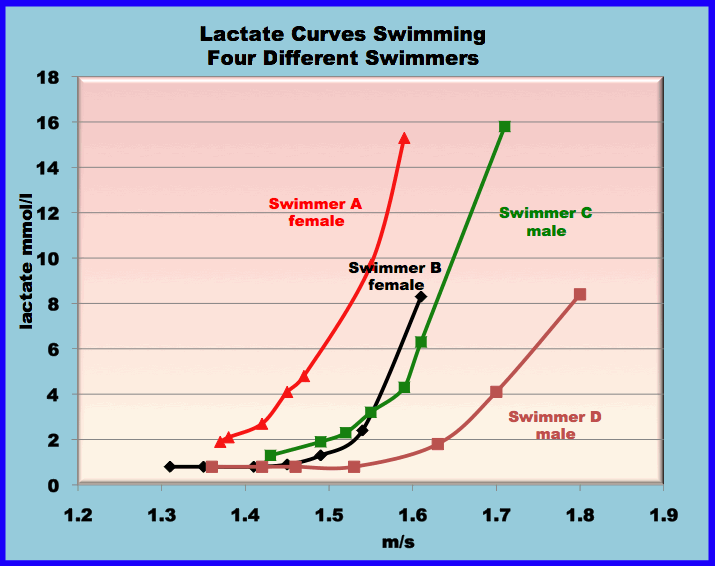
Control Tests
It is essential that the coach or athlete verify that the athlete's workouts are at the level planned – often triathletes go faster than prescribed because regenerative paces “feel easy”. That is why a control test is so important at various times during the training cycle. It is essential within a week or two after a standard lactate test to verify that the test was telling the coach the right things. For example, a swimmer was to swim most of his workouts at 1:15 to 1:17 and occasional sets just below the V4 pace at a higher intensity than these regenerative paces. So the coach had the athlete do a set of 10 x 100 m with 30 seconds rest a couple of seconds slower than the V4 pace. The results are below.
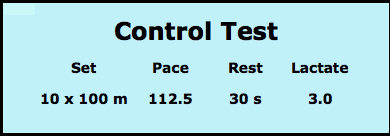
This set acted as part of the athlete's workout for the day and confirmed that the estimated paces for regeneration and extensive workouts were correct. Control tests are an excellent way to verify that an athlete is at the right intensity during a workout. It is also an excellent way to alert a coach and athlete that something is wrong. Suppose this exact same test was done three weeks later and the results were as follows:

The coach would know that something was wrong with the training paces and try to head off a major problem before the situation got worse.
Examples
The following is from Dr. Georgios Ziogas in Thessaloniki, Greece. He uses the Lactate Scout to test hundreds of athletes. Here is an example of a serious triathlete he tested and various recommendations for training paces.
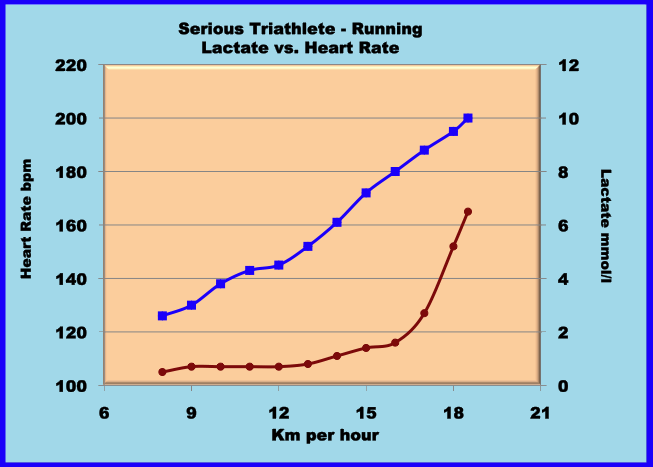
Dr. Ziogas prepared the following charts for this triathlete to help with his training. Notice for the long runs (14.8 km/hr.) and ultra long runs (12.5 km/hr), how the pace is very slow compared to the V4 pace (17.9 km/hr.) The ultra long runs are just 70% of the V4 pace, similar to our elite triathlete above.
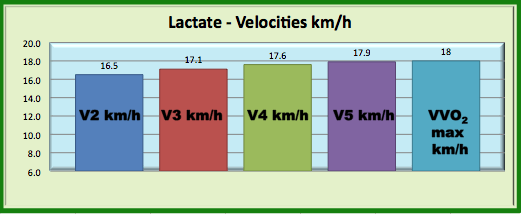
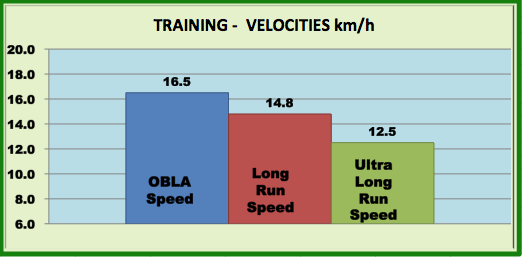
For more specific paces and heart rates the athlete will use the following chart.
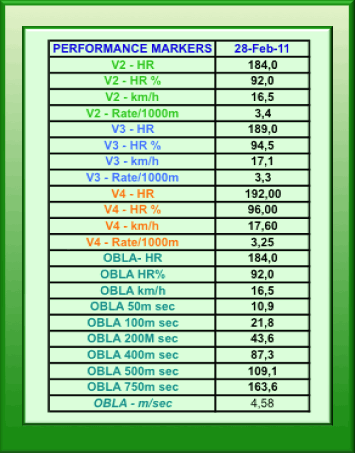
With these specific training paces and heart rates, the risk of an overly intense workout is greatly reduced. Of course the training program the athlete is using might prescribe training runs that are too fast, but lactate testing would alert the coach and the athlete of the danger. Then lactate testing, over time, would tell the coach and athlete whether or not that particular type of intense training was working. It is not 100% fail-safe, but over time fewer mistakes will be made if the athlete uses lactate testing to guide, monitor and assess training.
Here are results from another coach using the Lactate Plus for a male Ironman triathlete that qualified for Kona as an age grouper and has finished an Ironman in under 10 hours. The brown line is the lactate reading; the blue line is the heart rate. The lactate test included a power test or sprint test prior to the graded exercise test. The coach uses this to assess the top power that can be generated, as well as technique. That is why the initial lactate reading is higher than one would expect.
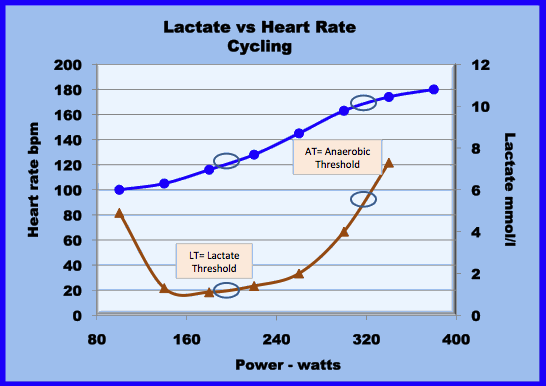

Notice that this coach uses different terminology than we do for the lactate threshold. This is ok as long as terms are used consistently. The important thing is the results of the training that will follow these recommendations. Also this coach used the wattage from a CompuTrainer to show the test results but she gave the training recommendation to the athlete based on his SRM Power Meter. So the training recommendation correlates with the lactate results, but does not reflect exactly the same numbers.
Here is another example from the same coach for running for a female triathlete competing in 70.3 events. The first chart includes RPE (rating of perceived effort) ratings and they are on the right axis with the lactate readings and range from 1-10.
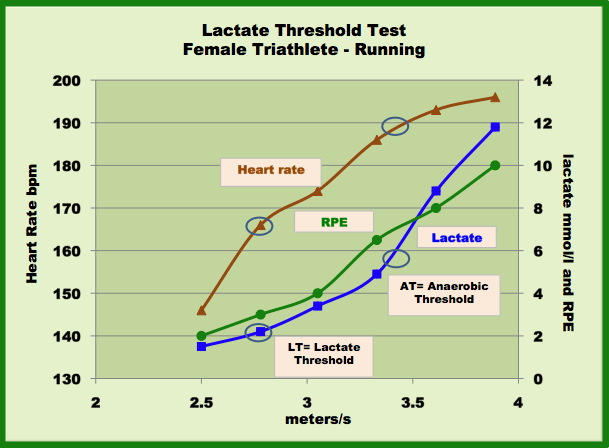
Next is a chart with exercise intensities based on the above testing. Eventually the athlete will use the perceived exertion measures as well as heart rate to monitor her training intensities. Remember perceived exertion is individual. The same perceived exertion level for two different athletes may have different implications for training intensity.

Continue on to Module 14 for a closer look at anaerobic energy processes and the Secrets of Lactate.
Module 14 of 19- a closer look at anaerobic energy processes and the Secrets of Lactate
